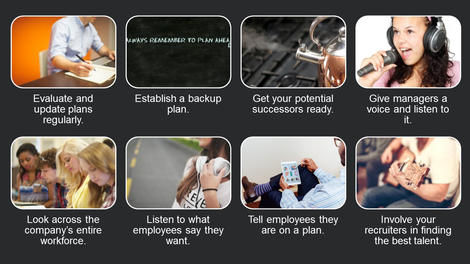 In 2017, Baby Boomers will be between 53 and 71 years old. Their waning numbers underline the need for good succession planning, especially since this segment likely represents the majority of the senior team. Yet 68% of firms have no formal succession plan leaving organizations at risk when baby boomers retire.
In 2017, Baby Boomers will be between 53 and 71 years old. Their waning numbers underline the need for good succession planning, especially since this segment likely represents the majority of the senior team. Yet 68% of firms have no formal succession plan leaving organizations at risk when baby boomers retire.
While succession planning is typically thought of as more of a learning and development discussion, more and more organizations are finding the need to tap recruiters’ skills for both external recruitment and internal redeployment of roles, finding talent that is often overlooked or neglected by traditional development methods.
Retirement Trends for 2017

According to Deltek’s 2016 A&E Clarity Report:
- 1 in 10 workers in the A&E industry fall into the Baby Boomer or Millennial categories.
- The average turnover is around 13.3%. Departing Baby Boomers are likely contributing to this number but turnover is being driven primarily by voluntary departures.
- As retirement rates accelerate for Baby Boomer-era partners who have historically bore the lion’s share of the Business Development burden, the responsibility is now spreading throughout the organization.
- 59% of firms have the same number of open positions as last year, while 1 in 4 firms reported more open positions and only 16% reported fewer. Large firms had the most unfilled jobs with more than 30% reporting a greater number of open spots than last year. Large firms are losing employees faster than their small and mid-sized counterparts, highlighting the need for better processes to engage and recruit employees.
- 70% of firms rank talent acquisition as one of their top three most expensive HR processes, with succession planning at the sixth most expensive.
- Just 19% of companies surveyed said they have a repository that helps them source and acquire talent for projects.
- 68% of firms have no formal succession plan or the plan applies only to a select few people leaving organizations at risk when baby boomers retire or a key member of the firm leaves unexpectedly.
- Prevent lack of leadership or critical talent
- Identify talent gaps
- Identify individuals with potential
- Speed up development
- Minimize leader turnover
- Discourage talent hoarding
Goals of Succession Plans
Shortcomings of Traditional Succession Planning

Succession plans fail when you don’t have the right mindset, processes, and support to make them succeed. There are some things you should definitely think about to reduce the chances that your plans will not work out.
- Don’t use the “set it and forget it” mentality. Let’s face it – things change and you need to make sure that you are able to account for those changes. People leave; availability changes; the company changes direction. You need to be thinking about these things when making plans and evaluate the plans regularly (at least once or twice a year) to make sure that you still have the best people identified as successors.
- Have a backup plan. Again, things change and you don’t want to be caught in a lurch if there are unforeseen changes. It is a good idea to have other potential successors identified provide for flexibility in succession planning.
- Develop your potential successors. Once you’ve identified potential successors, make sure you groom them so that they are ready if they need to step up. Under-developed leaders weaken the entire organization, erode workforce confidence, and impact job satisfaction. Make sure you have the resources in place to get your successors ready for the next step.
- Include managers in the process. This will not only broaden your search, but it fosters engagement. Both managers and team members feel they have a voice and are represented in the company’s planning.
- Consider your entire workforce. If you only consider HiPos, you may miss hidden talent. Don’t overlook talent that is new to the company. And make sure to consider all important criteria, not just past jobs held and skills/competencies.
- Listen to what your employees say they want. This encourages engagement, positively impacts retention rates, improves job satisfaction, contributes to overall business success and demonstrates support for employees’ goals and aspirations.
- Don’t keep your employees in the dark. Tell employees they are on a succession plan. This is a huge opportunity to impact retention in your highest performers, and this engagement can impact the bottom line. Also, keeping employees aware can motivate self-development.
Tapping Recruiter Skills for Finding Talent
Recruiters can be a great resource for identifying potential successors within your organization. They are already strong at sourcing for openings, and those same skills can come in handy for succession planning. Recruiters have multiple sources at their disposal, can ensure the job is the right fit, and can include external candidates.
Your recruiting team can also be a valuable resource in building career paths for employees, evaluating the quality of new hire, looking at HiPo employees to build interview questions, and sharing information with managers.
Another good reason for including recruiters is that sometimes (unfortunately) managers might not be the most reliable source for identifying potential successors. This happens when managers fail to develop their talent, either for their current role or future possibilities. Also, some managers will hold back employees who are ready for more because of the impact that would have on their team’s performance. Study after study identifies bad managers and lack of challenge/opportunity as the number one and number two reason people leave a job. This could lead to your best talent being deprived of growth opportunities and walking out the door.
From finding the best talent and the right fit for your company to looking internally at the possible employees who are best suited to take on a higher role. Understanding your company’s values and culture and having the right systems in place will help make the transition to the next role easier.
